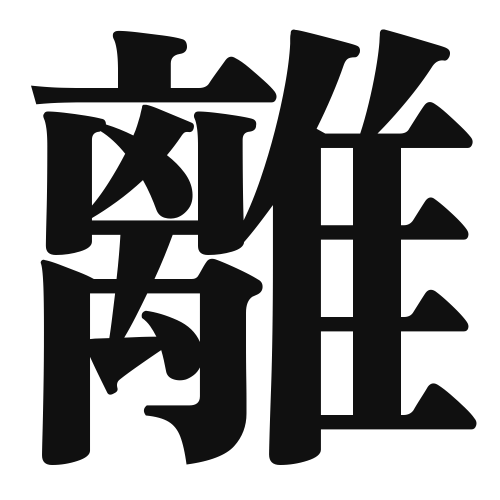1. Overview of Meaning
The kanji “離” (ri) primarily means “to separate” or “to leave.” It conveys the idea of distance or disconnection between people, objects, or concepts.
2. Formation and Radical
Formation of the Kanji: The kanji “離” is a compound character, which means it is formed by combining different elements. It consists of the radical “離” (which represents separation) and the phonetic component “里” (ri), which contributes to its pronunciation.
Radical: The radical for “離” is “離” itself, indicating its core meaning related to separation.
3. Examples of Usage
Common Words and Phrases: Some frequently used words that include “離” are:
- 離婚 (rikon) – divorce
- 離れる (hanareru) – to leave or to be separated
- 離島 (ritou) – remote island
Example Sentences in Daily Conversation:
- 彼は仕事のために家族から離れています。
(Kare wa shigoto no tame ni kazoku kara hanareteimasu.)
– He is separated from his family for work. - 私たちは離婚することに決めました。
(Watashitachi wa rikon suru koto ni kimemashita.)
– We decided to get a divorce.
4. Synonyms and Antonyms
Similar Kanji: A kanji with a similar meaning is “分” (bun), which means “to divide.” However, “分” often implies a more neutral or mathematical separation, while “離” carries a more emotional or relational connotation.
Antonyms: A kanji with an opposite meaning is “合” (gou), which means “to unite” or “to join.” This kanji represents the idea of coming together, contrasting with the separation implied by “離.”
5. Cultural and Historical Background
Relation to Japanese Culture: The concept of separation is significant in various aspects of Japanese culture, including literature and art, where themes of longing and distance are often explored.
Proverbs and Idioms: One common saying is “離れていても心は一つ” (Hanarete ite mo kokoro wa hitotsu), which translates to “Even if we are apart, our hearts are one.” This reflects the cultural value placed on emotional connections despite physical distance.
